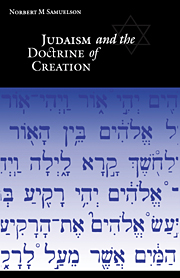Book contents
- Frontmatter
- Contents
- Preface
- Introduction
- PART 1 THE MODERN DOGMA OF CREATION
- PART 2 A JEWISH VIEW OF CREATION
- Chapter 3 Classical Jewish philosophy
- Chapter 4 Classical rabbinic commentaries
- PART 3 THE FOUNDATIONS FOR THE JEWISH VIEW OF CREATION
- PART 4 A BELIEVABLE VIEW OF CREATION
- Notes
- Select bibliography
- Indices
Chapter 3 - Classical Jewish philosophy
Published online by Cambridge University Press: 08 January 2010
- Frontmatter
- Contents
- Preface
- Introduction
- PART 1 THE MODERN DOGMA OF CREATION
- PART 2 A JEWISH VIEW OF CREATION
- Chapter 3 Classical Jewish philosophy
- Chapter 4 Classical rabbinic commentaries
- PART 3 THE FOUNDATIONS FOR THE JEWISH VIEW OF CREATION
- PART 4 A BELIEVABLE VIEW OF CREATION
- Notes
- Select bibliography
- Indices
Summary
This chapter is an argument for the claim that Rosenzweig's interpretation of creation is Jewish on the grounds that it is consistent and coherent with the view of creation that grew out of the development of medieval Jewish philosophy. The substance of the argument is a survey of the field on this particular question. After a brief introduction to set the historical context of the topic, it begins with the first Jewish Aristotelian, Abraham Ibn Daud, and concludes with the most rigorous, detailed Jewish philosophic interpretation of creation in this tradition – that of Gersonides. Particular attention will be paid to those topics on which Rosenzweig seems to depart most radically from Jewish tradition – the ontological status of space and its occupants, the nature of reality as positive and negative, the temporal modification of the act of divine creation, the relationship between ontology and ethics, and the epistemic status of the doctrine of creation.
The classical rabbis believed that the Hebrew scriptures were a record of the word of God. As such, the correct meaning of what the Bible says is true. The problem was to determine in every instance which of the many possible interpretations of the text was the correct one. One test was truth itself. Since the correct meaning of the scriptures is always true, any interpretation that is not true could not be the correct interpretation. To the extent that the claims of revelation were philosophical, e.g., the doctrine of creation, the rabbis used what they knew of philosophy to interpret their holy texts. In practical terms, accepted philosophical traditions provided the schemata through which the data from biblical texts were made intelligible.
- Type
- Chapter
- Information
- Judaism and the Doctrine of Creation , pp. 81 - 106Publisher: Cambridge University PressPrint publication year: 1994

